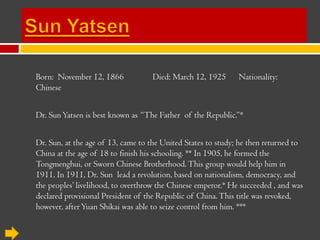
Testppl
- 1. Sun Yatsen Born: November 12, 1866 Died: March 12, 1925 Nationality: Chinese Dr. Sun Yatsen is best known as “The Father of the Republic.”* Dr. Sun, at the age of 13, came to the United States to study; he then returned to China at the age of 18 to finish his schooling. ** In 1905, he formed the Tongmenghui, or Sworn Chinese Brotherhood. This group would help him in 1911. In 1911, Dr. Sun lead a revolution, based on nationalism, democracy, and the peoples’ livelihood, to overthrow the Chinese emperor.* He succeeded , and was declared provisional President of the Republic of China. This title was revoked, however, after Yuan Shikai was able to seize control from him. ***
- 2. After Yuan gained power, Dr. Sun had to flee to Japan, where he joined the KMT. He returned to China with the KMT and tried to gain the Western countries’ support, but to no avail. He then turned to the Russian government for help and they agree.** The Russian involvement in China would forever change the course of Chinese history. With the Russian government’s help, Dr . Sun was able to begin a military conquest in Southern China, which he succeeded in gaining control of. Although he started the 1912 revolution based on democracy, the Russians and Dr. Sun believed that the Chinese people were not able to handle the responsibility to vote yet. He decided to implement a three part plan in which the Chinese people would learn how to use the power to vote.* Unfortunately, the plan never got past the first stage in which Dr. Sun was the dictator. In 1925, Dr. Sun died due to liver cancer. ****After his death, Dr. Sun’s ideas would become the basis of the Nationalist government established by Chiang Kai-shek in 1928. Since his death, Dr. Sun has evolved into a heroic symbol for modern China. ***
- 3. General Yuan Shi-kai Born: September 16, 1859 Died: June 6, 1916 Nationality: Chinese General Yuan Shi-kai is best known as the 1st President of the Republic of China. During the 1st Sino-Japanese War, General Shi-kai was the leader of the Beiyang Army, the first modern Chinese army, during the 1st Sino Japanese War. After the War, he used the Army to take control of the Chinese government from Dr. Sun Yatsen. From March 10, 1912 to January 1, 1916, General Shi-kai was the President of China. During this time, however, he tried to turn the republican government into an imperial one, which caused many Chinese to hate him. Tofuther hurt matters, on the 1st of January 1916, he declared himself Emperor of China. On March 22, 1916, General Shi-kai decided to reinstate the republican government, after many problems with both internal and external affairs. From this point on until his death in June, he began losing political power.
- 4. Chon Pong-jun Born: 1854 Died: 1895 Nationality: Korean Chon Pong-jun was the leader of the Tonghak movement in Cholla-do province. In 1984, the farmers of the Cholla-do province of Korea, protested against the unfair treatment they were receiving from government officials. When the government ignored their protest, the farmers turned to violence, which in turn led to government ordered executions. In response to this, a group of farmers, which included Chon Pong-jun, led a large uprising to Chonjo, where the Korean government army was defeated. Chon and the Korean government tried to work out a solution. Unfortunately, the Chinese responded to the plea the Korean government had issued, asking for their help, days before by sending in their military. This rebellion caused the Sino-Japanese War. Once the Japanese had control of Korea and had driven out China, the Japanese went looking for Chon and found him. He was arrested and then sentenced to death by beheading for his involvement and leadership role in the Tonahakunrising.
- 5. Beiyang Army Creation: In the late 1800 by the Qing government Alliance: China Leader During the Sino Japanese War: General Yuan Shi-kai The Beiyang Army was the first modern military of China. It was the prime army of the Chinese during the 1st Sino-Japanese War. After the War, the army was used to modernized the rest of the Chinese military. It would continue to control most of China until 1928, when it lost power due to warlordism.
- 6. Beiyang Fleet Creation: in 1871 by Li Hongzhang Alliance: China Leader During the Sino Japanese War: Admiral Ding Juchang, The Beiyang Fleet came about due to the Chinese defeat during the 2nd Opium War, during which the Chinese were defeated. It was one of the four modern Chinese navies. Each navy was in charge of a certain area; the Beiyang Fleet was in charge of protecting Northern China and Korea. Because this was the area the Fleet was to control, the Fleet was the only navy to fight the Japanese during the 1st Sino-Japanese War.
- 7. Imperial Japanese Army Creation: 1869 Alliance: Japan Leader During the Sino Japanese War: Major-General OshimaYoshimasa The Imperial Japanese Army was formed by Emperor Meiji, because the emperor understood the need for Japan’s military to modernize. The Army was modeled of the German Army. The fact that the Japanese Army was modernized earlier than their Chinese counterparts would play a large part in their success during the 1st Sino-Japanese War.
- 8. Imperial Japanese Navy Creation: 1869 Alliance: Japan Leader During the Sino Japanese War:ItohSukeyuki In 1869, Emperor Mejij formed the Imperial Japanese Navy. This navy was the first modern navy of Japan. The INJ was modeled of the British navies. It was responsible for the destruction of the Beiyang Navy during the Sino-Japanese War. HOME
Hinweis der Redaktion
- *https://www.wsu.edu/~dee/MODCHINA/SUN.HTM**http://library.thinkquest.org/26469/movers-and-shakers/sun.html***http://www.vancouverchinesegarden.com/about/dr_sun_yat_sen.htm
- ****http://www.nndb.com/people/902/000092626/
- http://net.lib.byu.edu/estu/wwi/bio/xyz/yuansh.htmlhttp://library.thinkquest.org/26469/movers-and-shakers/shikai.html
- http://www.bookrags.com/research/tonghak-ema-05/http://www.koreanhistoryproject.org/Ket/C27/E2702.htmhttp://www.k365.com/history/71.htmIf you have trouble finding a pic with this name try using Chon Pong-chun. That chould work.
- http://www.chinatoday.com.cn/English/e2005/e200509/p74.htmhttp://publishing.cdlib.org/ucpressebooks/view?docId=ft167nb0p4&chunk.id=d0e5798&toc.depth=100&toc.id=d0e5763&brand=escholhttp://history.cultural-china.com/en/47H7755H12708.html
- http://ocw.mit.edu/ans7870/21f/21f.027/throwing_off_asia_02/toa_essay05.htmlhttp://sinojapanesewar.com/forces.htm
- http://www.cityofart.net/bship/sino-jap.htmlhttp://history.cultural-china.com/en/34H6639H12252.html
- http://sinojapanesewar.com/forces.htm